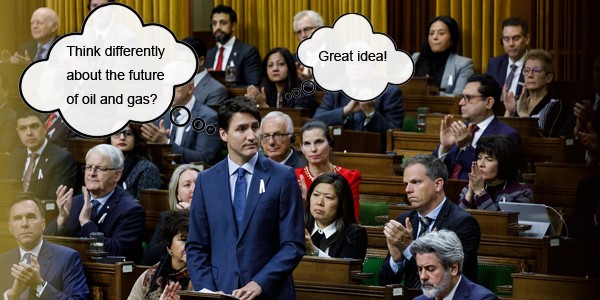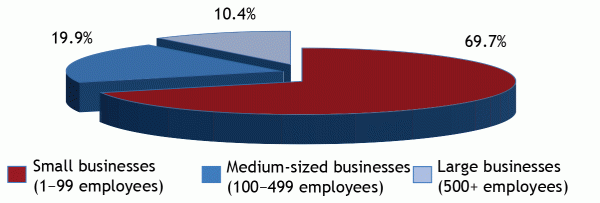
This may sound mercenary, but now is the perfect time to force a deeply conservative industry that hates change to change more rapidly
Bail out the oil and gas industry or invest in the clean energy future? This is supposedly the debate taking place within the Liberal cabinet, according to Canadian Press, as it scrambles to support the Canadian economy during the COVID-19 pandemic. If the report is accurate, Justin Trudeau and company are having the wrong conversation.
This isn’t, or shouldn’t be, an either/or proposition, a question of hydrocarbons vs. renewables. That Canada still frames the energy transition and climate change debate this way in 2020 demonstrates just how backward we are on energy matters.
Here’s a better way to frame the discussion about how to help the Canadian oil and gas sector.
Imagine a point in the future, say 2050, in which greenhouse gas emissions from hydrocarbon production are essentially eliminated, the market for fuels made from crude oil has peaked several decades previous and is declining, while the market for petrochemicals and materials like carbon fibre made from oil sands bitumen is expanding.
Some version of this scenario is quite plausible by mid-century and very likely a decade or two after. It’s what a net-zero emissions, post-combustion world will probably look like.
As policymakers debate the oil and gas support program, they should be pondering how Canada can best invest scarce resources to help the hydrocarbon sector pivot to the new energy future. To quote that great Canadian sage, Walter Gretzky, “Skate to where the puck is going, not where it has been.”
Here are two questions the Prime Minister and his cabinet colleagues should address in their energy support package.
Which companies are unlikely to transition to a low-carbon, post-combustion future?
Several types immediately come to mind: junior producers pumping less than 10,000 barrels per day and small service companies. Not coincidentally, this is the political backbone of the United Conservative Party. Premier Kenney retweeted an open letter, published in Monday’s Financial Post, from oilfield CEOs and industry organizations asking Ottawa to save the industry:
Specifically, the Canadian drilling and service rig sector needs the federal government to introduce a payroll relief plan. We’re also asking the federal government to purchase our accounts receivable — at a discount. Doing this would give our companies instant cash flow and the federal government could collect these debts at a profit as oil prices recover.
Both those requests might be defended for solvent intermediate producers and larger service companies with a sound balance sheet, but not for the juniors and the mom-and-pop service firms. Many of these companies are hanging on by their fingertips, having never fully recovered from the 2015/16 downturn. They’re still in business only by the grace of Canadian banks reluctant to pull credit for businesses whose assets are nearly worthless.
How bad is it?
In mid-July, nine producers wrote Kenney begging for help to “avert a crisis in the natural gas sector which could result in widespread corporate failures, significant job loss..” The CEOs blamed persistent low prices, pipeline congestion, as well as the Supreme Court’s Redwater decision that prevented bankrupt companies from escaping their environmental obligations but also dried up credit for struggling companies.
In January, Keith Chatwin and Gordon Masson wrote in The Lawyers Daily that of the public oil and gas companies that ceased to be “reporting issuers” in 2019, 30 per cent were bankrupt or insolvent, while 50 per cent received cease trade orders. Only two juniors were acquired or went private.
This suggests that if Ottawa buys accounts receivable, as the oil and gas CEOs want, the odds are too high that most recipients would be long gone by the time prices recover – if they recover.
The federal government should not prop up failing companies already on the verge of collapse.
Which companies have a good chance of transitioning to a low-carbon, post-combustion future?
The answer to this question is the seniors (companies producing over 100,000 b/d) and intermediates (producing between 10,000 and 100,000 b/d), mid-sized and large domestic service companies, the significant but often overlooked oilfield manufacturers, and the rapidly growing cleantech sector.
An April 1 IHS MarkIt blog post described how big global players are implementing energy transition strategies that invest in internal R&D, purchase technology startups, or invest in them, as Canadian giant Suncor has done with Enerkem. Currently, three per cent of industry capital expenditures fund transition strategies, but IHS MarkIt expects the trend to grow.
Three criteria should be uppermost on the minds of federal cabinet members as they consider how to support
One, the Canadian oil and gas industry already spends heavily on R&D to reduce greenhouse gas emissions, especially when operating costs are reduced at the same time. Demand more cuts and a commitment to achieve them sooner – 2030 or 2040 instead of the largely aspirational 2050 targets set by some oil sands producers.
Two, hydrocarbons as feedstock to materials or low-emissions fuels. Governments fund agencies like Alberta Innovates and the Emissions Reduction Agency to develop new low-emission and non-combustion products like carbon fibre from bitumen and “blue hydrogen” from natural gas.
New technologies like carbon capture and storage, cleantech, and helping
Workers vs. companies
 On Monday, the Trudeau government launched the Canada Emergency Response Benefit for workers, the self-employed, and small businesses. That’s a great start because employees should be the top priority. Companies employing less than 99 people account for 70 per cent of Canadian private sector employment, according to the Canadian government.
On Monday, the Trudeau government launched the Canada Emergency Response Benefit for workers, the self-employed, and small businesses. That’s a great start because employees should be the top priority. Companies employing less than 99 people account for 70 per cent of Canadian private sector employment, according to the Canadian government.
But which other companies within the hydrocarbon sector also deserve support? Not all of them, certainly. As Energi Media readers often point out on social media, the Kenney government has already been very generous – for example, lowering the corporate tax rate from 12 to 8 per cent – to oil and gas companies.
Tough choices must be made by policymakers responsible for Canadian tax dollars. They should be guided by one overriding principle: don’t waste valuable capital that is best spent helping the oil patch skate to where the puck is going, not where it’s been.
Don’t support already failing firms: the Canadian government should under no circumstances buy the accounts receivable of floundering service companies or pour cash into failing junior producers. Companies fail, that’s just a fact of business life, and sometimes investors and banks just have to take their lumps.
Do support those companies that are committed to lowering GHG emissions, whose product can be a feedstock for non-combustion manufacturing (carbon fibre) or low-emissions fuel (hydrogen), and innovators creating the energy technologies of the future. Be generous with research organizations, like Alberta Innovates and the universities of Alberta and Canada. Fund more technical training for workers because the hydrocarbon industry is rapidly adopting digital technologies like artificial intelligence and the nature of work is changing.
And don’t be afraid to attach strings. Plenty of strings. This may sound mercenary, but now is the perfect time to force a deeply conservative industry that hates change to change more rapidly.
That’s the conversation the federal cabinet should be having.


Be the first to comment